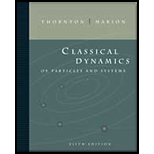
Classical Dynamics of Particles and Systems
5th Edition
ISBN: 9780534408961
Author: Stephen T. Thornton, Jerry B. Marion
Publisher: Cengage Learning
expand_more
expand_more
Solutions are available for other sections.
Question
error_outline
This textbook solution is under construction.
Students have asked these similar questions
Two mass points of mass m1 and m2 are connected by a string passing through a hole in a smooth table so that m1 rests on the table surface and m2 hangs suspended. Assuming m2 moves only in a vertical line, what are the generalized coordinates for the system? Write the Lagrange equations for for the system and, if possible, discuss the physical significance any of them might have. Reduce the problem to a single second-order differential equation and obtain a first integral of the equation. What is its physical significance? (Consider the motion only until m1 reaches the hole.)
A point mass is constrained to move on a massless hoop of radius a fixedin a vertical plane that rotates about its vertical symmetry axis with constantangular speed ω. Obtain the Lagrange equations of motion assuming the only external forces arise from gravity. What are the constants of motion? Show that if ω is greater than a critical value ω0, there can be a solution in which the particle remains stationary on the hoop at a point other than at thebottom, but that if ω < ω0, the only stationary point for the particle is atthe bottom of the hoop. What is the value of ω0?
A particle of mass m described by one generalized coordinate q movesunder the influence of a potential V(q) and a damping force −2mγq˙ proportional to its velocity with the Lagrangian L = e2γt(1/2 * mq˙2 − V (q)) which gives the desired equation of motion.
(a) Consider the following generating function: F = eγtqP - QP.Obtain the canonical transformation from (q,p) to (Q,P) and the transformed Hamiltonian K(Q,P,t).
(b) Let V (q) = (1/2)mω2q2 be a harmonic potential with a natural frequency ω and note that the transformed Hamiltonian yields a constant of motion. Obtain the solution Q(t) for the damped oscillator in the under damped case γ < ω by solving Hamilton's equations in the transformed coordinates. Then, write down the solution q(t) using the canonical coordinates obtained in part (a).
Knowledge Booster
Similar questions
- Prove the following: if the Hamiltonian is independent of time, then ∆E doesn't change in time. Show work and be explicit to prove the statement.arrow_forwardFor a one dimensional system, x is the position operator and p the momentum operator in the x direction.Show that the commutator [x, p] = iharrow_forwardConsider a particle of spin s = 3/2. (a) Find the matrices representing the operators S^ x , S^ y ,S^ z , ^ Sx 2 and ^ S y 2 within the basis of ^ S 2 and S^ z (b) Find the energy levels of this particle when its Hamiltonian is given by ^H= ϵ 0 h 2 ( Sx 2−S y 2 )− ϵ 0 h ( S^ Z ) where ϵ 0 is a constant having the dimensions of energy. Are these levels degenerate? (c) If the system was initially in an eigenstate Ψ0=( 1 0 0 0) , find the state of the system at timearrow_forward
- Evaluate the commutator [Â,B̂] of the following operators.arrow_forwardProve that using x(t) = Asin (ωt + ϕ) will produce the same results for the period for the oscillations of a mass and a spring. Why do you think the cosine function was chosen?arrow_forwardA point particle moves in space under the influence of a force derivablefrom a generalized potential of the formU(r, v) = V (r) + σ · L,where r is the radius vector from a fixed point, L is the angular momentumabout that point, and σ is the fixed vector in space. Find the components of the force on the particle in spherical polar coordinates, on the basis of the equation for the components of the generalized force Qj: Qj = −∂U/∂qj + d/dt (∂U/∂q˙j)arrow_forward
- I have been able to do this with derivatives but I can't figure out how to do this with definite integralsarrow_forwardProve the Jacobi identity: A × (B × C) + B × (C × A) + C × (A × B) = 0. Hint:Expand each triple product as in equations (3.8) and (3.9).arrow_forwardCalculate the energy, corrected to first order, of a harmonic oscillator with potential:arrow_forward
arrow_back_ios
arrow_forward_ios
Recommended textbooks for you
 Classical Dynamics of Particles and SystemsPhysicsISBN:9780534408961Author:Stephen T. Thornton, Jerry B. MarionPublisher:Cengage Learning
Classical Dynamics of Particles and SystemsPhysicsISBN:9780534408961Author:Stephen T. Thornton, Jerry B. MarionPublisher:Cengage Learning

Classical Dynamics of Particles and Systems
Physics
ISBN:9780534408961
Author:Stephen T. Thornton, Jerry B. Marion
Publisher:Cengage Learning